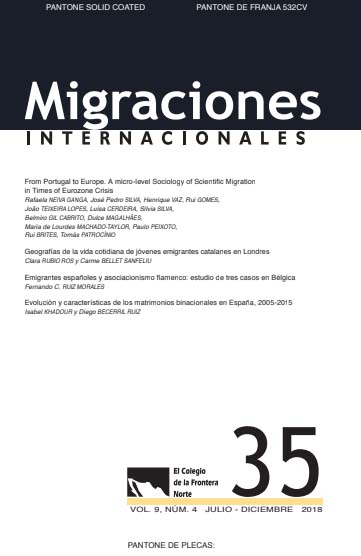Return to the Land of Origins: Sense of Belonging in Argentine Dual-Citizen Immigrants Residing in Milan
DOI:
https://doi.org/10.17428/rmi.v9i35.513Keywords:
doble ciudadanía, fronteras cultuales, fronteras políticas, inmigrantes argentinos, MilánAbstract
This article describes how immigrants in Milan, who are considered citizens of return in the Italian state, develop a sense of belongign to one or more nation-states. The study describes the political boundaries and the cultural boundaries that frame their experiences. For this purpose, immigrants from Argentina who are dual citizens and reside in Milan are interviewed. In recent decades, Italy has become a place of mass immigration; however, it continues to grant citizenship through ius sanguinis. This means only a few types of immigrants (as dual citizens) have unrestricted access and perceive themselves as a member of the state.References
Bajtin, M.M. (1981). The Dialogic Imagination, Four Essays. M. Holquist (Ed.). Austin, TX y Londres, UK: University of Texas Press.
Bourdieu, P. (1999). La miseria del mundo. Buenos Aires, Fondo de Cultura Económica.
Brubaker, R. (2001). The Return of Assimilation? Changing Perspectives on Immigration and Its sequels in France, Germany and the United States. Ethnic and Racial Studies, 24(4), 531-548.
Calvelo, L. (2011). Tendencias y patrones de la emigración argentina entre 1960 y 2010. En L. Luchillo (Coord). Más allá de la fuga de cerebros: movilidad, migración y diásporas de argentinos calificados (pp. 69-90). Buenos Aires: Eudeba.
Comisión Económica para América Latina y el Caribe. (2006). Migración internacional, derechos humanos y desarrollo. Santiago de Chile: Naciones Unidas.
Clifford, J. (2001). Dilemas de la cultura. Antropología, literatura y arte en la perspectiva posmoderna. Barcelona: Gedisa.
Devoto, F. (1992). Movimientos migratorios, historiografía y problemas. Buenos Aires: Centro Editor de América Latina.
Durand, J. (2006). Los inmigrantes también emigran: la migración de retorno como corolario del proceso. Revista Interdisciplinar da mobilidade humana, 14(26-27), en http://www.csem.org.br/remhu/index.php/remhu/issue/view/1
Fabietti, U. (2000). L’identità etnica. Roma: Carocci.
Faist, T. (2007). Citizenship. Discourse, Theory and Transnational Prospects. Reino Unido: Blackwell.
Geertz, C. (2003). La interpretación de las culturas. Barcelona: Gedisa
Germani, G. (1968). Política y sociedad en una época de transición. Buenos Aires: Paidós
Kornblit, A. L., (2004). Historias y relatos de vida: una herramienta clave en metodologías cualitativas. En A. Kornblit (Coord.). Metodologías cualitativas en ciencias sociales (pp.15-34). Buenos Aires: Editorial Biblos.
Kymlicka, W. (1997). Le sfide del multiculturalismo. Rivista Il Mulino, (2), 199-217.
Lozano, J.; Peña-Marín, C. y Abril, G. (1993). Análisis del discurso. Hacia una semiótica de la interacción textual. Madrid: Cátedra.
Marradi, A., Archenti, N. y Piovani, J. I. (2010). Metodología de las Ciencias Sociales. Buenos Aires: Cengage.
Mera, C., Halpern, G. (2011). Migraciones internacionales: repensando las ciudades y sus políticas. Revista Latina de Sociología, (1), 98-125. Recuperado de http://revistas.udc.es/index.php/RELASO/article/view/1197/272
Ministero degli Affari Esteri. (2016). Rientro definitivo in Italia. Recuperado de esteri.it Servizi consolari/rimpatrio http://www.esteri.it/mae/it/italiani_nel_mondo/serviziconsolari/assistenzacittadiniestero/rimpatri.html
Novick, S. (2008). Migración y políticas en Argentina: Tres leyes para un país extenso (1876-2004). En S. Novick Comp.). Las migraciones en América Latina. Políticas, culturas y estrategias (pp. 131-152). Buenos Aires: Clacso/ Catálogos
Oficina Europea de Estadística. (2011). Population Census 2011 ec.europa.eu/eurostat, Luxemburgo, Argumento Data Population Census 2011. Recuperado de https://ec.europa.eu/Censushub2/query.do?step=selectHyperCube&countrycode=en&clearS ession=true
Pacecca, M. I. y Courtis, C. (2008). Inmigración contemporánea en Argentina: dinámicas y políticas. Santiago de Chile: CEPAL .
Pellegrino, A. (2003). La migración internacional en América Latina y el Caribe: tendencias y perfiles de los migrantes (Serie Población y Desarrollo 35). Santiago de Chile: CEPAL-CELADE. Recuperado de http://repositorio.cepal.org/bitstream/handle/11362/7172/S033146_es.pdf
Portes, A. y Zhou, M. (1993). The New Second Generation: Segmented Assimilation and Its Variants. Annals of the American Academy of Political and Social Science, 1(530), 74-96.
Renán, E. (2010). ¿Qué es una Nación?. En H. Bhabha (Comp.) Nación y narración: entre la ilusión de una identidad y las diferencias culturales (pp. 21-38). Buenos Aires: Siglo XXI editores.
Sayad, A. (2002). La doppia assenza. Dalle illusionidell’emigrato alle sofferenze dell’immigrato. Milano: Cortina.
Schmitt, C. (2009). El concepto de lo político. Madrid: Alianza.
Torpey, John , 2000, The Invention of the Passport. Surveillance, Citizenship and the State. Cambridge, Cambridge University Press.
Unión Europea. (2004). Tratado por el que se establece una Constitución Europea, Ciudadanía de la Unión. Artículo I_10 Ciudadanía de la Unión. Recuperado de http://eurlex.europa.eu/JOHtml.do?uri=OJ:C:2004:310:SOM:ES:HTML
Zanfrini, L. (2007). Cittadinanze. Appartenenza e diritti nella societá dell’immigrazione. Roma, Bari, Italia: Gius. Laterza & Figli.
Downloads
Published
Issue
Section
License
Copyright (c) 2018 Migraciones Internacionales

This work is licensed under a Creative Commons Attribution-NonCommercial-NoDerivatives 4.0 International License.
Authors publishing work in this journal agree to the following conditions:
Authors retain copyright and assign first publication rights to the journal Migraciones Internacionales (MI), with the texts registered under an Attribution-NonCommercial-NoDerivatives 4.0 International Creative Commons license (CC BY-NC-ND 4.0), which allows third parties to use published material provided they give credit to the authors and acknowledge this journal as the first publisher.
They authorize the reproduction, publication, translation, communication, and transmission of their paper and all accompanying material, publicly and in any form and by any means; its public distribution in as many copies as required; and public communication thereof in any form, including making it available to the public through electronic means or any other technology, and solely for dissemination and scientific, cultural, and non-commercial purposes.
Authors may enter into further independent contractual agreements for the non-exclusive distribution of the version of the paper published in this journal (for instance, to include it in an institutional repository or personal webpage, or publish it in a book), provided it is not for commercial purposes and they clearly state that the work was first published in Migraciones Internacionales (MI) [and add the corresponding bibliographical record: Author/s (Year). Title of paper. Migraciones Internacionales, volume (number), pp. doi: xxxx].
To that end, authors must submit the form assigning ownership of first publication rights, duly completed and signed. This document is to be uploaded in PDF format as a complementary file on the OJS platform.
This work is released under an Attribution-NonCommercial-NoDerivatives 4.0 International Creative Commons license (CC BY-NC-ND 4.0)..













